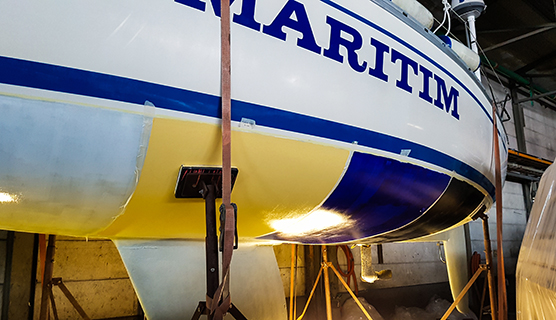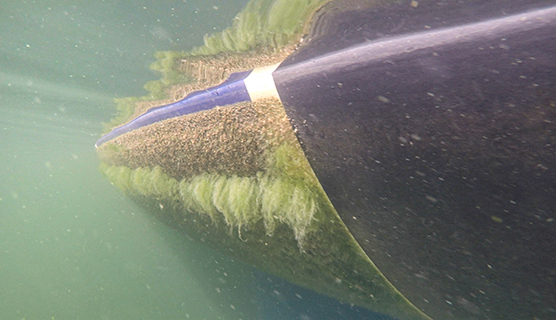Press release 2021-02-11 at 9:00
CORRECTION 12.5.2021 / “Plenty of biofouling appeared in between the brushings when using these eco-paints”, new formulation “Plenty of biofouling appeared before the brushing when using these eco-paints”

Antifouling paints being tested in the hull of Kari "Ruffe" Nurmi's sailboat. © Kari Nurmi
Five antifouling paints for recreational craft were tested as part of the EU-funded COMPLETE project, which seeks concrete actions for the prevention of the arrival and spread of non-indigenous species in the Baltic Sea Region. The growth and composition of sessile organisms attached varied between the antifouling paints. The results show that the antifouling paint choices made by recreational boaters may significantly impact the spread of invasive species.
Five antifouling paints were included
In the experiment, the hull of a sailboat was coated with five different antifouling paints and a section of the hull was left uncoated for comparison purposes. The effectiveness of the paints and the growth of biofouling was studied during one sailing season from April to October. During that time, the boat sailed around the Gulf of Finland and the Archipelago Sea. Three of the paints were so-called eco-paints (Seaboost Overdrive, Hempel Silic One, International Trilux Hard Eco), and two of them contained biocides (International Trilux, Hempel Hard Racing Xtra). Towards the end of the boating season, small sections of the areas painted with Seaboost and Trilux Hard Eco were cleaned by hand in order to determine how well the fouling would come off the surface. In the autumn, the boat was lifted out of the water and the number of attached taxa, as well as fouling rate of each section were analysed. The hull of the boat was washed with a boat washer installed at the Hanko Eastern Harbour, after which the hull was re-examined.

The hull of the boat was painted with five different antifouling paints. © Kari Nurmi
Non-indigenous species detected among the biofouling
13 different taxa were found among the biofouling adhering to the hull of the sailboat, including two non-indigenous species: the bay barnacle (Amphibalanus improvisus) and a recent invader, the tiny tanaid Sinelobus vanhaareni. The most abundant taxa found on the boat hull were the bay barnacle, the tanaid, the blue mussel, and lake fly larvae. Tanaids were most common where the hull was covered with bay barnacles and blue mussels.
In addition to the hull, samples were also collected from the propeller and the rudder (so-called niche areas), where earlier studies had found more diverse biofouling. In this study, the biofouling on the hull was not significantly different from that on the niche areas. The ragworm (Hediste diversicolor) was however only found in samples collected from the propeller and the rudder. All other species that were present on the propeller and the rudder were also present on the hull.
Some paints require cleaning during the sailing season
There were notable differences between the paints after the sailing season. No biofouling was found at the end of the sailing season on the hard toxic paints (International Trilux, Hempel Hard Racing Xtra) or the eco-paint Hempel Silic One. The largest volume of biofouling was observed on the eco-paint Trilux Hard Eco, closely followed by the eco-paint Seaboost Overdrive. On the sections painted with these eco-paints the amount of biofouling was even greater than on the uncoated control surfaces. After the hull was washed the surfaces painted with the eco-paints Hempel Silic One and Seaboost Overdrive and the biocidal paints International Trilux and Hempel Racing Xtra were completely free of any biofouling. Even brushing could not remove the entire growth of biofouling from the non-painted control surfaces, nor surfaces painted with the eco-paint International Hard Eco, as some barnacle attachment plates remained on these surfaces.

The difference between hard toxic paint and eco-paint was clear. © Kari Nurmi
From the perspective of the boat user, all tested paints work: they reduce friction and help the boat maintain speed. The eco-paints Seaboost Overdrive and International Trilux Hard Eco also help keeping the bottom of the boat clean, provided that it is brushed several times during the season. Plenty of biofouling appeared before the brushing when using these eco-paints, which may increase the risk of spreading non-indigenous species during sailing season.
Opportunities for washing the boat hull without lifting the boat are currently very limited in Finland as there is only one drive-in boat washer in the whole country. Hand brushing is the only alternative to the boat washer if the boat is cleaned without lifting. In this case, the brushed organisms may fall back into the water during the wash, allowing non-indigenous species to spread.
The COMPLETE project “Completing management options in the Baltic Sea Region to reduce risk of invasive species introduction by shipping” is co-financed by the European Union’s funding Programme Interreg Baltic Sea Region (European Regional Development Fund).
More information
- Research Professor Maiju Lehtiniemi, Finnish Environment Institute SYKE, e-mail: firstname.lastname@syke.fi, tel. +358 295 251 356
- Sailor, adventurer Kari ’Ruffe’ Nurmi, e-mail: ruffe@ruffe.fi, tel. +358 40 505 4412
- Management coordinator of the COMPLETE project Miina Karjalainen, Kotka Maritime Research Association, e-mail: firstname.lastname@merikotka.fi, tel. +358 44 5222 843
- Researcher Okko Outinen, Finnish Environment Institute, e-mail: firstname.lastname@syke.fi, tel. +358 295 251 915
-
Link to the COMPLETE project website
Images for media use
Antifouling paints tested in the hull of a sailboat (JPG, 2Mb)
Clear difference between eco-paint and toxic paint (JPG, 1,5Mb)
Difference between eco-paints (JPG, 2Mb)
Difference between toxic paint and uncoated area (JPG, 1,7Mb)
Differences in biofouling in test areas (JPG, 2,4Mb)
Painting different surfaces (JPG, 1,4Mb)
Uncoated area (JPG, 2,4Mb)